MENU
The Electronic Scholarly Publishing Project: Providing access to classic scientific papers and other scholarly materials, since 1993. More About: ESP | OUR CONTENT | THIS WEBSITE | WHAT'S NEW | WHAT'S HOT
Comparative Timelines
The ESP Timeline (one of the site's most popular features) has been completely updated to allow the user to select (using the timeline controls above each column) different topics for the left and right sides of the display.
Select:
New Left Column
New Left Column
Dates
Decade
New Right Column
New Right Column
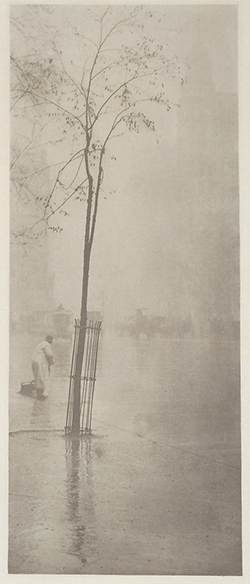 Photograph by Alfred Stieglitz: Spring Showers, The Street Cleaner.
Photograph by Alfred Stieglitz: Spring Showers, The Street Cleaner.
 Booker T. Washington publishes Up from Slavery, his autobiography.
Booker T. Washington publishes Up from Slavery, his autobiography.
Kodak introduces their first Brownie, a very inexpensive user-reloadable point-and-shoot box camera.
 K. Landsteiner discovers the blood-agglutination phenomenon in man.
K. Landsteiner discovers the blood-agglutination phenomenon in man.
 Karl Pearson develops the chi-square test.
Karl Pearson develops the chi-square test.
 Paul Karl Ludwig Drude shows that moving electrons conduct electricity in metals.
Paul Karl Ludwig Drude shows that moving electrons conduct electricity in metals.
 Paul Ulrich Villard is the first to observe a radiation that is more penetrating than X-rays, now called gamma rays.
Paul Ulrich Villard is the first to observe a radiation that is more penetrating than X-rays, now called gamma rays.
 On December 14, Max Planck announces the first step toward quantum theory. He states that substances can emit light only at certain energies, which implies that some physical processes are not continuous, but occur only in specified amounts called quanta.
On December 14, Max Planck announces the first step toward quantum theory. He states that substances can emit light only at certain energies, which implies that some physical processes are not continuous, but occur only in specified amounts called quanta.
1900
(no entry for this year)
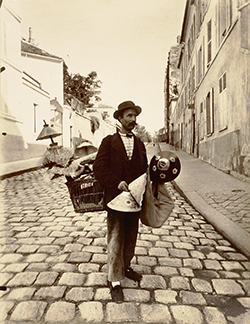 Eug ne Atget: Marchand d'Abat-Jours, an albumen silver print, now in the J. Paul Getty Museum.
Eug ne Atget: Marchand d'Abat-Jours, an albumen silver print, now in the J. Paul Getty Museum.
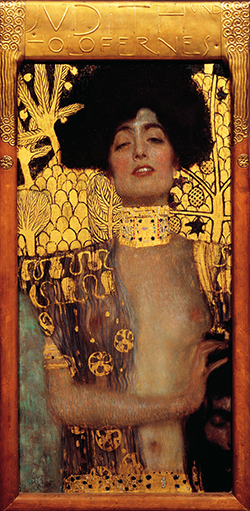 Painting by Gustav Klimt: Judith and the Head of Holofernes (also known as Judith I) depicts the biblical character of Judith holding the severed head of Holofernes. Judith I reveals a curious symbolic and compositional consonance with The Sin by Franz Stuck: the temptation illustrated by the German painter becomes the model for Klimt's femme fatale by suggesting the posture of the disrobed and evanescent body as focal piece of the canvas, as well as the facial set. Judith's force originates from the close-up and the solidity of posture, rendered by the orthogonal projection of lines: to the body's verticality (and that of Holofernes') corresponds to the horizontal parallels in the lower margin: those of the arm, the shoulders joined by the collier, and finally the hair base.
Painting by Gustav Klimt: Judith and the Head of Holofernes (also known as Judith I) depicts the biblical character of Judith holding the severed head of Holofernes. Judith I reveals a curious symbolic and compositional consonance with The Sin by Franz Stuck: the temptation illustrated by the German painter becomes the model for Klimt's femme fatale by suggesting the posture of the disrobed and evanescent body as focal piece of the canvas, as well as the facial set. Judith's force originates from the close-up and the solidity of posture, rendered by the orthogonal projection of lines: to the body's verticality (and that of Holofernes') corresponds to the horizontal parallels in the lower margin: those of the arm, the shoulders joined by the collier, and finally the hair base.
Herman Hollerith patents Apperatus For Punching Record Cards
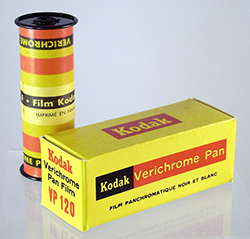 Kodak introduces the 120 film format.
Kodak introduces the 120 film format.
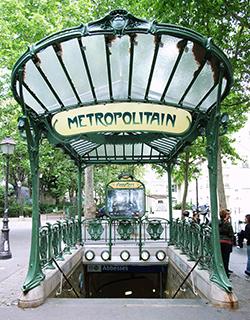 The Metro subway opens in Paris.
The Metro subway opens in Paris.
 Theodore Roosevelt becomes twenty-sixth president of the United States.
Theodore Roosevelt becomes twenty-sixth president of the United States.
 Queen Victoria dies and is succeeded by her son, Edward VII.
Queen Victoria dies and is succeeded by her son, Edward VII.
 H. de Vries adopts the term MUTATION to describe sudden, spontaneous, drastic alterations in the hereditary material of Oenothera.
H. de Vries adopts the term MUTATION to describe sudden, spontaneous, drastic alterations in the hereditary material of Oenothera.
T. H. Montgomery studies spermatogenesis in various species of Hemiptera. He concludes that maternal chromosomes only pair with paternal chromosomes during meiosis.
 Harry Govier Seeley publishes Dragons of the Air, the first popular book on pterosaurs, arguing that they were warm-blooded and should be classified parallel to birds, in between reptiles and mammals. This is in direct opposition to Richard Owen's classification of pterosaurs as cold-blooded and poor flyers.
Harry Govier Seeley publishes Dragons of the Air, the first popular book on pterosaurs, arguing that they were warm-blooded and should be classified parallel to birds, in between reptiles and mammals. This is in direct opposition to Richard Owen's classification of pterosaurs as cold-blooded and poor flyers.
1901
(no entry for this year)
Arthur Korn devises practical telephotography technology (reduction of photographic images to signals that can be transmitted by wire to other locations).Wire-Photos are in wide use in Europe by 1910, and transmitted to other continents by 1922.
 T. Boveri studies sea urchin embryos and finds that in order to develop normally, the organism must have a full set of chromosomes, and from this he concludes that the individual chromosomes must carry different essential hereditary determinants.
T. Boveri studies sea urchin embryos and finds that in order to develop normally, the organism must have a full set of chromosomes, and from this he concludes that the individual chromosomes must carry different essential hereditary determinants.
 William Bateson coins terms that will become essential to describing findings in the new science of heredity: GENETICS, F1, F2, ALLELOMORPH (later shortened to ALLELE), HOMOZYGOTE, HETEROZYGOTE, and EPISTASIS.
William Bateson coins terms that will become essential to describing findings in the new science of heredity: GENETICS, F1, F2, ALLELOMORPH (later shortened to ALLELE), HOMOZYGOTE, HETEROZYGOTE, and EPISTASIS.
Barnum Brown of the American Museum of Natural History discovers Tyrannosaurus rex.
1902
(no entry for this year)
 Richard Steiff designs the first teddy bears, named after Pres. Teddy Roosevelt.
Richard Steiff designs the first teddy bears, named after Pres. Teddy Roosevelt.
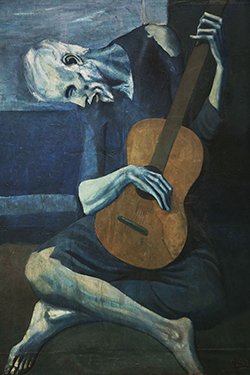 Painting by Pablo Picasso: The Old Guitarist depicts an old, blind, haggard man with threadbare clothing weakly hunched over his guitar, playing in the streets of Barcelona, Spain. It is currently on display in the Art Institute of Chicago as part of the Helen Birch Bartlett Memorial Collection. At the time of The Old Guitarist's creation, Modernism, Impressionism, Post-Impressionism, and Symbolism had merged and created an overall movement called Expressionism which greatly influenced Picasso's style. Furthermore, El Greco, Picasso's poor standard of living, and the suicide of a dear friend influenced Picasso's style at the time which came to be known as his Blue Period. In the early 1960s, nearly forty percent of all college dorm rooms had a poster of this painting on the wall.
Painting by Pablo Picasso: The Old Guitarist depicts an old, blind, haggard man with threadbare clothing weakly hunched over his guitar, playing in the streets of Barcelona, Spain. It is currently on display in the Art Institute of Chicago as part of the Helen Birch Bartlett Memorial Collection. At the time of The Old Guitarist's creation, Modernism, Impressionism, Post-Impressionism, and Symbolism had merged and created an overall movement called Expressionism which greatly influenced Picasso's style. Furthermore, El Greco, Picasso's poor standard of living, and the suicide of a dear friend influenced Picasso's style at the time which came to be known as his Blue Period. In the early 1960s, nearly forty percent of all college dorm rooms had a poster of this painting on the wall.
 W. E. B. Du Bois' The Souls of Black Folk is published on April 27. Du Bois rejects the gradualism of Booker T. Washington and calls for agitation on behalf of African-American rights.
W. E. B. Du Bois' The Souls of Black Folk is published on April 27. Du Bois rejects the gradualism of Booker T. Washington and calls for agitation on behalf of African-American rights.
The first motor taxis appear in London
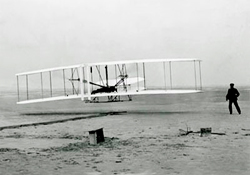 Orville and Wilbur Wright succeed with the first controlled flight in a heavier-than-air machine.
Orville and Wilbur Wright succeed with the first controlled flight in a heavier-than-air machine.
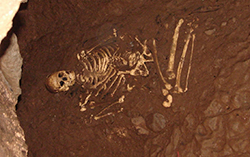 Cheddar Man, a human male fossil, is discovered at Gough's Cave in Cheddar Gorge, England. Sometimes referred to as the earliest Englishman, Cheddar Man turns out to be only about 15,000 years old. it appears that he died a violent death. A large crater-like lesion just above the skull's right orbit suggests that the man may have also been suffering from a bone infection at the time. It is Britain s oldest complete human skeleton.
Cheddar Man, a human male fossil, is discovered at Gough's Cave in Cheddar Gorge, England. Sometimes referred to as the earliest Englishman, Cheddar Man turns out to be only about 15,000 years old. it appears that he died a violent death. A large crater-like lesion just above the skull's right orbit suggests that the man may have also been suffering from a bone infection at the time. It is Britain s oldest complete human skeleton.
 The concepts of PHENOTYPE, GENOTYPE, and SELECTION were introduced and clearly defined by Wilhelm Ludwig Johannsen.
The concepts of PHENOTYPE, GENOTYPE, and SELECTION were introduced and clearly defined by Wilhelm Ludwig Johannsen.
L. de Vesly describes first- to third-century remains at Gallo Roman temples and wells near Rouen, France. Finds there include a cache of Neolithic axes and fossil sea urchins — evidence of association of axes and urchins over thousands of years.
 Carl Neuberg first used the term BIOCHEMISTRY.
Carl Neuberg first used the term BIOCHEMISTRY.
Physicist Ernest Rutherford lectures the British Association that radioactivity could power the sun and maintain its heat, meaning the sun and Earth could be much older than Lord Kelvin's estimate.
1903
(no entry for this year)
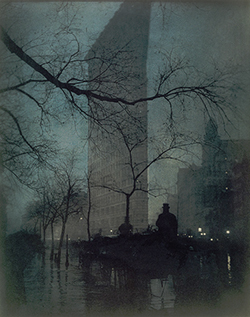 Photograph by Edward Steichen: The Flatiron Building depicts the recently erected Flatiron Building in New York, taking inspiration from fellow photographers like Alfred Stieglitz, who had just photographed the building a year prior. The original negative was made in 1904 and spawned three platinum-gum exhibition prints in brown (1905), blue-green (1909), and yellow-green-black (1904–1909; uncertain).  Using different proportions of pigments in each gum process, Steichen was able to create these three unique platinum-gum prints. The photograph's most notable variant is the blue-green version, which, according to Penelope Niven, became "widely reproduced from 1909 onward" because of its intense color contrasts. The significance of the prints as a whole comes from how they showcase what Niven refers to as the "artistic potential" of photography. The work is one of the best-known photographs of Steichen's Pictorialist phase.
Photograph by Edward Steichen: The Flatiron Building depicts the recently erected Flatiron Building in New York, taking inspiration from fellow photographers like Alfred Stieglitz, who had just photographed the building a year prior. The original negative was made in 1904 and spawned three platinum-gum exhibition prints in brown (1905), blue-green (1909), and yellow-green-black (1904–1909; uncertain).  Using different proportions of pigments in each gum process, Steichen was able to create these three unique platinum-gum prints. The photograph's most notable variant is the blue-green version, which, according to Penelope Niven, became "widely reproduced from 1909 onward" because of its intense color contrasts. The significance of the prints as a whole comes from how they showcase what Niven refers to as the "artistic potential" of photography. The work is one of the best-known photographs of Steichen's Pictorialist phase.
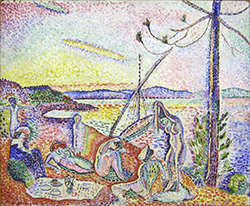 Painting by Henri Matisse: Luxe, Calme et Volupt is an oil painting by the French artist Henri Matisse. Both foundational in the oeuvre of Matisse and a pivotal work in the history of art, Luxe, Calme et Volupt is considered the starting point of Fauvism. Luxe, Calme et Volupt was painted by artist called Matisse in 1904, after a summer spent working in St. Tropez on the French Riviera alongside the neo-Impressionist painters Paul Signac and Henri-Edmond Cross. The painting is Matisse's most important work in which he used the Divisionist technique advocated by Signac.
Painting by Henri Matisse: Luxe, Calme et Volupt is an oil painting by the French artist Henri Matisse. Both foundational in the oeuvre of Matisse and a pivotal work in the history of art, Luxe, Calme et Volupt is considered the starting point of Fauvism. Luxe, Calme et Volupt was painted by artist called Matisse in 1904, after a summer spent working in St. Tropez on the French Riviera alongside the neo-Impressionist painters Paul Signac and Henri-Edmond Cross. The painting is Matisse's most important work in which he used the Divisionist technique advocated by Signac.
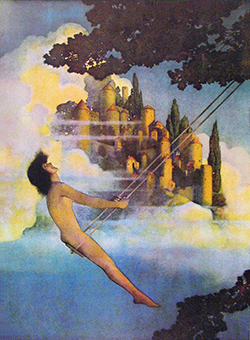 Painting by Maxfield Parrish: The Dinky Bird, an illustration from Poems of Childhood exemplifies Parrish's characteristic use of androgynous figures. To a modern eye, Parrish's early work — characterized by himself as "girls on rocks" — may bring to mind the words kitsch or schlock or schmaltz or maudlin, but to many who were enduring the Great Depression or World War II, his images, like Busby Berkeley musicals, inspired a bit of hope — an imagining that things did not always have to be this bad. During those hard times, many a lower middle class American living room had one or more cheap Parrish prints, sometimes just a page from a magazine, adorning the wall.
Painting by Maxfield Parrish: The Dinky Bird, an illustration from Poems of Childhood exemplifies Parrish's characteristic use of androgynous figures. To a modern eye, Parrish's early work — characterized by himself as "girls on rocks" — may bring to mind the words kitsch or schlock or schmaltz or maudlin, but to many who were enduring the Great Depression or World War II, his images, like Busby Berkeley musicals, inspired a bit of hope — an imagining that things did not always have to be this bad. During those hard times, many a lower middle class American living room had one or more cheap Parrish prints, sometimes just a page from a magazine, adorning the wall.
The Rolls-Royce company is founded in Britain.
The Russo-Japanese war begins with a surprise attack by the Imperial Japanese Navy against the Russian far East Fleet, while it was at anchor at Port Arthur.
 Entomologist George Willis Kirkaldy publishes species descriptions of a series of insects whose names all end in "-chisme" (pronounced "kiss me"), such as Ohchisme, Dolichisme, Elachisme, Florichisme, Isachisme, Marichisme, Nanichisme, Peggichisme, and Polychisme. Kirkaldy's proposed names preface -chisme with the names of various women from alleged romantic conquests. In 1912 a letter to the International Entomological Congress from Lord Walsingham sought to make these names invalid on the basis of their being non-classical in their derivation. Kirkaldy himself had been a firm adherent to the principle of priority and was against any form of orthographic emendation to the spelling proposed by the original authors.
Entomologist George Willis Kirkaldy publishes species descriptions of a series of insects whose names all end in "-chisme" (pronounced "kiss me"), such as Ohchisme, Dolichisme, Elachisme, Florichisme, Isachisme, Marichisme, Nanichisme, Peggichisme, and Polychisme. Kirkaldy's proposed names preface -chisme with the names of various women from alleged romantic conquests. In 1912 a letter to the International Entomological Congress from Lord Walsingham sought to make these names invalid on the basis of their being non-classical in their derivation. Kirkaldy himself had been a firm adherent to the principle of priority and was against any form of orthographic emendation to the spelling proposed by the original authors.
1904
(no entry for this year)
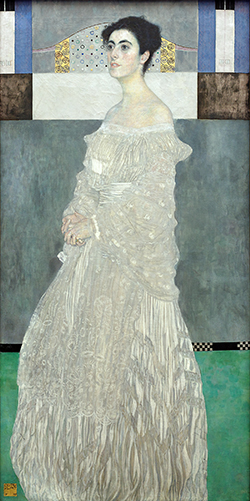 Painting by Gustav Klimt: Margaret "Gretl" Stonborough-Wittgenstein. Stonborough-Wittgenstein, a member of the prominent and wealthy Viennese Wittgenstein family, was a sister of the philosopher Ludwig Wittgenstein and the pianist Paul Wittgenstein. She was the subject of a portrait painted for her wedding by the artist Gustav Klimt (Stonborough-Wittgenstein and other members of the Wittgenstein family were among Klimt's most important patrons), which was sold in 1960 by her son Thomas and may now be seen in the Neue Pinakothek gallery in Munich. Aside: The painting appears briefly behind Ava, an AI robot, in the film Ex Machina (a film that is an excellent exploration of artificial intelligence, the nature of consciousness, and passing a Turing Test).
Painting by Gustav Klimt: Margaret "Gretl" Stonborough-Wittgenstein. Stonborough-Wittgenstein, a member of the prominent and wealthy Viennese Wittgenstein family, was a sister of the philosopher Ludwig Wittgenstein and the pianist Paul Wittgenstein. She was the subject of a portrait painted for her wedding by the artist Gustav Klimt (Stonborough-Wittgenstein and other members of the Wittgenstein family were among Klimt's most important patrons), which was sold in 1960 by her son Thomas and may now be seen in the Neue Pinakothek gallery in Munich. Aside: The painting appears briefly behind Ava, an AI robot, in the film Ex Machina (a film that is an excellent exploration of artificial intelligence, the nature of consciousness, and passing a Turing Test).
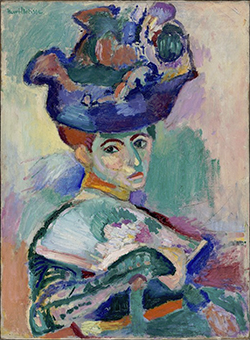 Painting by Henri Matisse: Woman with a Hat (La femme au chapeau) depicts Matisse's wife, Amelie. It was painted in 1905 and exhibited at the Salon d'Automne during the fall of the same year, along with works by André Derain, Maurice de Vlaminck and several other artists known as "Fauves". Woman with a Hat was at the center of the controversy that led to the term Fauvism. It was also a painting that marked a stylistic shift in the work of Matisse from the Divisionist brushstrokes of his earlier work to a more expressive style. Its loose brushwork and "unfinished" quality shocking viewers as much as its vivid, non-naturalistic colors. Although the Fauve works on display were condemned by many — "A pot of paint has been flung in the face of the public", declared the critic Camille Mauclair — they also gained some favorable attention. The painting that was singled out for attacks was Matisse's Woman with a Hat.
Painting by Henri Matisse: Woman with a Hat (La femme au chapeau) depicts Matisse's wife, Amelie. It was painted in 1905 and exhibited at the Salon d'Automne during the fall of the same year, along with works by André Derain, Maurice de Vlaminck and several other artists known as "Fauves". Woman with a Hat was at the center of the controversy that led to the term Fauvism. It was also a painting that marked a stylistic shift in the work of Matisse from the Divisionist brushstrokes of his earlier work to a more expressive style. Its loose brushwork and "unfinished" quality shocking viewers as much as its vivid, non-naturalistic colors. Although the Fauve works on display were condemned by many — "A pot of paint has been flung in the face of the public", declared the critic Camille Mauclair — they also gained some favorable attention. The painting that was singled out for attacks was Matisse's Woman with a Hat.
The first motorized buses operate in London.
 The first neon signs appear.
The first neon signs appear.
 An obscure Swiss patent clerk, Albert Einstein, formulates the special theory of relativity and ushers in the atomic age.
An obscure Swiss patent clerk, Albert Einstein, formulates the special theory of relativity and ushers in the atomic age.
The National Forest Service is established in the United States by Gifford Pinchot.
K. S. Merezhkovsky suggests that chloroplasts originated as a cyanobacterium swallowed by a protozoan, i.e., algal and plant cells result from two independent organisms that became symbionts. The idea will be largely forgotten until it is suggested again in the 1960s.
 Lucien Claude Cuénot performs crosses between mice carrying a gene that gives them yellow fur. Since they always produce yellow furred and agouti offspring in a 2:1 ratio, he concludes they are heterozygous. (In 1910, W. E. Castle and C. C. Little will show that yellow homozygotes die in utero. This dominant allele is thus the first gene shown to behave as a homozygous lethal.)
Lucien Claude Cuénot performs crosses between mice carrying a gene that gives them yellow fur. Since they always produce yellow furred and agouti offspring in a 2:1 ratio, he concludes they are heterozygous. (In 1910, W. E. Castle and C. C. Little will show that yellow homozygotes die in utero. This dominant allele is thus the first gene shown to behave as a homozygous lethal.)
 The Swimming Reindeer — the largest ivory carving from the late Ice Age yet found — is pieced together by Abbé Henri Breuil from two reindeer carved from mammoth ivory found decades earlier by Peccadeau de l'Isle.
The Swimming Reindeer — the largest ivory carving from the late Ice Age yet found — is pieced together by Abbé Henri Breuil from two reindeer carved from mammoth ivory found decades earlier by Peccadeau de l'Isle.
Albert Einstein proposes the special theory of relativity (E=mc2).
1905
(no entry for this year)
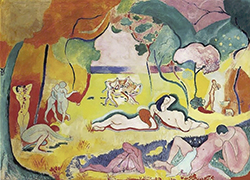 painting by Henri Matisse: Le bonheur de vivre (The Joy of Life) is (along with Picasso's Les Demoiselles d'Avignon) regarded as one of the pillars of early modernism. The monumental canvas was first exhibited at the Salon des Indépendants of 1906, where its cadmium colors and spatial distortions caused a public expression of protest and outrage. "The work is known to have invigorated fellow artists, especially Pablo Picasso, who, in an effort to outdo Matisse in terms of shock value, immediately began work on his watershed Les Demoiselles D'Avignon," writes Martha Lucy, associate curator at the Barnes Foundation.
painting by Henri Matisse: Le bonheur de vivre (The Joy of Life) is (along with Picasso's Les Demoiselles d'Avignon) regarded as one of the pillars of early modernism. The monumental canvas was first exhibited at the Salon des Indépendants of 1906, where its cadmium colors and spatial distortions caused a public expression of protest and outrage. "The work is known to have invigorated fellow artists, especially Pablo Picasso, who, in an effort to outdo Matisse in terms of shock value, immediately began work on his watershed Les Demoiselles D'Avignon," writes Martha Lucy, associate curator at the Barnes Foundation.
Computer Pioneer Grace Hopper is Born
 An All-India Muslim League is founded by Sultan Mahommed Shah, Aga Khan III.
An All-India Muslim League is founded by Sultan Mahommed Shah, Aga Khan III.
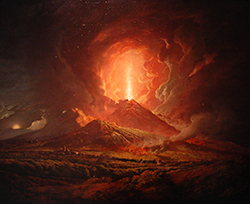 Mount Vesuvius erupts, devastating the town of Ottaiano, Italy
Mount Vesuvius erupts, devastating the town of Ottaiano, Italy
The Great San Francisco Earthquake kills seven hundred people and causes more than $400 million in property losses.
The world's largest battleship — the Satsuma — is launched in Japan.

 William Bateson and Reginald Crundall Punnett report the discovery of two new genetic principles: LINKAGE and GENE INTERACTION.
William Bateson and Reginald Crundall Punnett report the discovery of two new genetic principles: LINKAGE and GENE INTERACTION.
In his presidential address to the Geological Society of America, Raphael Pumpelly claims that the end of the Pleistocene started the Neolithic Revolution.
1906
 Upton Sinclair publishes The Jungle.
Upton Sinclair publishes The Jungle.
Kenneth Grahame publishes The Wind in the Willows.
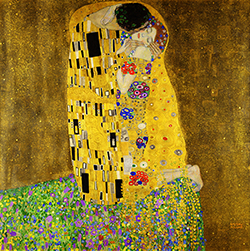 Painting by Gustav Klimt : The Kiss (Lovers) was painted by the Austrian Symbolist painter Gustav Klimt between 1907 and 1908, the highpoint of his "Golden Period", when he painted a number of works in a similar gilded style. A perfect square, the canvas depicts a couple embracing, their bodies entwined in elaborate robes decorated in a style influenced by both linear constructs of the contemporary Art Nouveau style and the organic forms of the earlier Arts and Crafts movement. The work is composed of oil paint with applied layers of gold leaf, an aspect that gives it its strikingly modern, yet evocative appearance. The painting is now in the sterreichische Galerie Belvedere museum in the Belvedere palace, Vienna, and is widely considered a masterpiece of the early modern period. It is a symbol of Vienna Jugendstil Viennese Art Nouveau and is considered Klimt's most popular work
Painting by Gustav Klimt : The Kiss (Lovers) was painted by the Austrian Symbolist painter Gustav Klimt between 1907 and 1908, the highpoint of his "Golden Period", when he painted a number of works in a similar gilded style. A perfect square, the canvas depicts a couple embracing, their bodies entwined in elaborate robes decorated in a style influenced by both linear constructs of the contemporary Art Nouveau style and the organic forms of the earlier Arts and Crafts movement. The work is composed of oil paint with applied layers of gold leaf, an aspect that gives it its strikingly modern, yet evocative appearance. The painting is now in the sterreichische Galerie Belvedere museum in the Belvedere palace, Vienna, and is widely considered a masterpiece of the early modern period. It is a symbol of Vienna Jugendstil Viennese Art Nouveau and is considered Klimt's most popular work
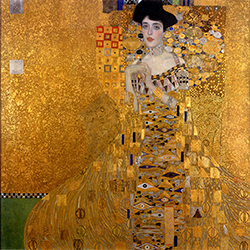 Painting by Gustav Klimt: Portrait of Adele Bloch-Bauer I (also called The Lady in Gold or The Woman in Gold) was completed between 1903 and 1907. The portrait was commissioned by the sitter's husband, Ferdinand Bloch-Bauer, a Jewish banker and sugar producer. It is the final and most fully representative work of Klimt's golden phase. The portrait was the first of two depictions of Adele by Klimt — the second was completed in 1912; these were two of several works by the artist that the family owned. Adele died in 1925; her will asked that the artworks by Klimt were to be left to the Österreichische Galerie Belvedere, although these belonged to Ferdinand, not her.
Painting by Gustav Klimt: Portrait of Adele Bloch-Bauer I (also called The Lady in Gold or The Woman in Gold) was completed between 1903 and 1907. The portrait was commissioned by the sitter's husband, Ferdinand Bloch-Bauer, a Jewish banker and sugar producer. It is the final and most fully representative work of Klimt's golden phase. The portrait was the first of two depictions of Adele by Klimt — the second was completed in 1912; these were two of several works by the artist that the family owned. Adele died in 1925; her will asked that the artworks by Klimt were to be left to the Österreichische Galerie Belvedere, although these belonged to Ferdinand, not her.
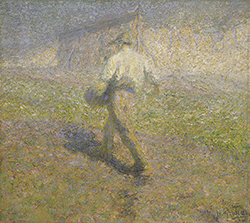 Painting by Ivan Grohar: The Sower (Slovene: Sejalec), is an image of a peasant sowing seeds on a ploughed field in an early and foggy morning. A hayrack, typical of the Slovene landscape, stands in the back, and even farther, the rocks of the small hill Kamnitnik near Škofja Loka. It has been a metaphor for the 19th-century myth of Slovenes as a vigorous nation in front of an unclear destiny, a symbol for the Slovene nation that sows in order that it could harvest, and a depiction of human interrelatedness with the nature. It is also a reflection of the context of Slovene transition from a rural to an urban culture. It has become one of the most characteristic and established Slovene creations in visual arts.
Painting by Ivan Grohar: The Sower (Slovene: Sejalec), is an image of a peasant sowing seeds on a ploughed field in an early and foggy morning. A hayrack, typical of the Slovene landscape, stands in the back, and even farther, the rocks of the small hill Kamnitnik near Škofja Loka. It has been a metaphor for the 19th-century myth of Slovenes as a vigorous nation in front of an unclear destiny, a symbol for the Slovene nation that sows in order that it could harvest, and a depiction of human interrelatedness with the nature. It is also a reflection of the context of Slovene transition from a rural to an urban culture. It has become one of the most characteristic and established Slovene creations in visual arts.
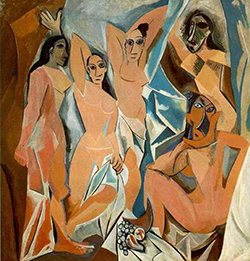 Painting by Pablo Picasso: Les Demoiselles d'Avignon (The Young Ladies of Avignon, and originally titled The Brothel of Avignon) portrays five nude female prostitutes from a brothel on Carrer d'Avinyó (Avinyó Street) in Barcelona. Each figure is depicted in a disconcerting confrontational manner and none are conventionally feminine. In this adaptation of Primitivism and abandonment of perspective in favor of a flat, two-dimensional picture plane, Picasso makes a radical departure from traditional European painting. This proto-Cubist work is widely considered to be seminal in the early development of both Cubism and Modern art. Les Demoiselles was revolutionary and controversial, and led to widespread anger and disagreement, even amongst the painter's closest associates and friends. Matisse considered the work something of a bad joke, yet indirectly reacted to it in his 1908 Bathers with a Turtle. Braque too initially disliked the painting, yet perhaps more than anyone else, studied the work in great detail. And effectively, his subsequent friendship and collaboration with Picasso led to the Cubist revolution
Painting by Pablo Picasso: Les Demoiselles d'Avignon (The Young Ladies of Avignon, and originally titled The Brothel of Avignon) portrays five nude female prostitutes from a brothel on Carrer d'Avinyó (Avinyó Street) in Barcelona. Each figure is depicted in a disconcerting confrontational manner and none are conventionally feminine. In this adaptation of Primitivism and abandonment of perspective in favor of a flat, two-dimensional picture plane, Picasso makes a radical departure from traditional European painting. This proto-Cubist work is widely considered to be seminal in the early development of both Cubism and Modern art. Les Demoiselles was revolutionary and controversial, and led to widespread anger and disagreement, even amongst the painter's closest associates and friends. Matisse considered the work something of a bad joke, yet indirectly reacted to it in his 1908 Bathers with a Turtle. Braque too initially disliked the painting, yet perhaps more than anyone else, studied the work in great detail. And effectively, his subsequent friendship and collaboration with Picasso led to the Cubist revolution
Henri Matisse coins the term "Cubism" — the first Cubist exhibition opens in Paris.
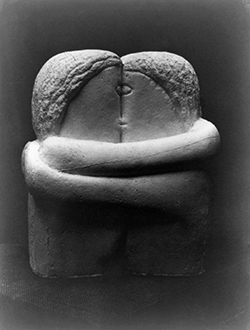 Sculpture by Constantin Brâncusi: The Kiss is an early example of his proto-cubist style of non-literal representation. This plaster was exhibited at the 1913 Armory Show and published in the Chicago Tribune, 25 March 1913. This early plaster sculpture is one of six casts that Brancusi made of the 1907–08 The Kiss. The original stone carving is in the Muzeul de Arta at Craiova, Romania. Brâncusi created many versions of The Kiss, further simplifying geometric forms and sparse objects in each version, tending each time further toward abstraction. His abstract style emphasizes simple geometrical lines that balance forms inherent in his materials with the symbolic allusions of representational art. Here, the shape of the original block of material is maintained.
Sculpture by Constantin Brâncusi: The Kiss is an early example of his proto-cubist style of non-literal representation. This plaster was exhibited at the 1913 Armory Show and published in the Chicago Tribune, 25 March 1913. This early plaster sculpture is one of six casts that Brancusi made of the 1907–08 The Kiss. The original stone carving is in the Muzeul de Arta at Craiova, Romania. Brâncusi created many versions of The Kiss, further simplifying geometric forms and sparse objects in each version, tending each time further toward abstraction. His abstract style emphasizes simple geometrical lines that balance forms inherent in his materials with the symbolic allusions of representational art. Here, the shape of the original block of material is maintained.
 Alain Locke of Philadelphia, a Harvard graduate, becomes the first African-American Rhodes scholar to study at Oxford University in England.
Alain Locke of Philadelphia, a Harvard graduate, becomes the first African-American Rhodes scholar to study at Oxford University in England.
The Autochrome plate is introduced. It becomes the first commercially successful color photography product.
Robert Baden-Powell founds the Boy Scout movement, in Britain.
Chemist Bertram Boltwood measures the ratio of isotopes of uranium and lead in a mineral from Connecticut. He concludes the mineral formed 410 million years ago. His estimate will later be changed to 265 million, but this experiment lays the groundwork for radiometric dating techniques.
P. Raymond describes a Neolithic deposit in Saône-et-Loire in France containing an axe with three fossil sea urchins.
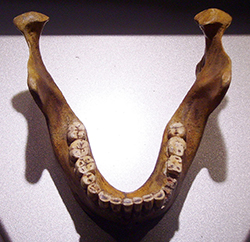 The Mauer jaw is discovered in Germany. On October 21, 1907, Daniel Hartmann, a worker at a sand mine in the Grafenrain open field system of the Mauer community unearthed a mandible at a depth of 24.63 m (80.81 ft), which he recognized as of human origin.[4] He was aware of the likelihood of finds, as for 20 years the Heidelberg scholar Otto Schoetensack had asked that the workers at the sand mine be encouraged to look out for fossils, after the well-preserved skull of a straight-tusked elephant had come to light there in 1887. Schoetensack had the workers taught the characteristics of human bones based on recent examples on his regular visits to the sand mine in search for "traces of mankind". The mandible will become the type specimen for Homo heidelbergensis (Archaic Homo sapiens, precursors to Neanderthals).
The Mauer jaw is discovered in Germany. On October 21, 1907, Daniel Hartmann, a worker at a sand mine in the Grafenrain open field system of the Mauer community unearthed a mandible at a depth of 24.63 m (80.81 ft), which he recognized as of human origin.[4] He was aware of the likelihood of finds, as for 20 years the Heidelberg scholar Otto Schoetensack had asked that the workers at the sand mine be encouraged to look out for fossils, after the well-preserved skull of a straight-tusked elephant had come to light there in 1887. Schoetensack had the workers taught the characteristics of human bones based on recent examples on his regular visits to the sand mine in search for "traces of mankind". The mandible will become the type specimen for Homo heidelbergensis (Archaic Homo sapiens, precursors to Neanderthals).
1907
(no entry for this year)
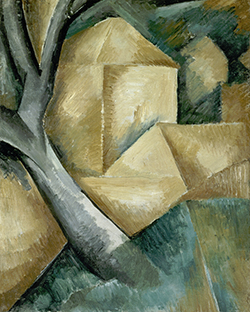 Painting by Georges Braque: Houses at l'Estaque (French: Maisons à l'Estaque) is considered either an important Proto-Cubist landscape or the first Cubist landscape. The painting prompted art critic Louis Vauxcelles to mock it as being composed of cubes which led to the name of the movement. This painting by Braque was refused at the Salon d'Automne in 1908. Louis Vauxcelles recounted how Matisse told him at the time, "Braque has just sent in [to the 1908 Salon d'Automne] a painting made of little cubes". The critic Charles Morice relayed Matisse's words and spoke of Braque's little cubes. The motif of the viaduct at l'Estaque had inspired Braque to produce three paintings marked by the simplification of form and deconstruction of perspective. Six landscapes painted at L'Estaque signed Georges Braque were presented to the Jury of the Salon d'Automne: Guérin, Marquet, Rouault and Matisse rejected Braque's entire submission. Guérin and Marquet elected to keep two in play. Braque withdrew the two in protest, placing the blame on Matisse.
Painting by Georges Braque: Houses at l'Estaque (French: Maisons à l'Estaque) is considered either an important Proto-Cubist landscape or the first Cubist landscape. The painting prompted art critic Louis Vauxcelles to mock it as being composed of cubes which led to the name of the movement. This painting by Braque was refused at the Salon d'Automne in 1908. Louis Vauxcelles recounted how Matisse told him at the time, "Braque has just sent in [to the 1908 Salon d'Automne] a painting made of little cubes". The critic Charles Morice relayed Matisse's words and spoke of Braque's little cubes. The motif of the viaduct at l'Estaque had inspired Braque to produce three paintings marked by the simplification of form and deconstruction of perspective. Six landscapes painted at L'Estaque signed Georges Braque were presented to the Jury of the Salon d'Automne: Guérin, Marquet, Rouault and Matisse rejected Braque's entire submission. Guérin and Marquet elected to keep two in play. Braque withdrew the two in protest, placing the blame on Matisse.
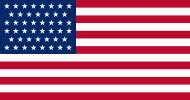 The US flag is modified to have forty-six stars, reflecting the addition of one new state: Oklahoma.
The US flag is modified to have forty-six stars, reflecting the addition of one new state: Oklahoma.
Kinemacolor, a two-color process known as the first commercial "natural color" system for movies, is introduced.
General Motors Corporation is formed.
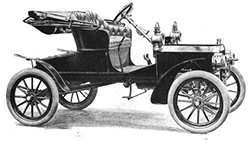 The Ford Motor Company produces the first Model T. Ultimately, more than 15 million will be produced.
The Ford Motor Company produces the first Model T. Ultimately, more than 15 million will be produced.
The Young Turk revolution restores the Constitution and parliamentary government in the Ottoman Empire.
 Godfrey Harold Hardy, a Cambridge mathematician, writes a letter to the editor of Science, suggesting that Mendelian mechanisms acting alone have no effect on allele frequencies. The letter begins, I am reluctant to intrude in a discussion concerning matters of which I have no expert knowledge, and I should have expected the very simple point which I wish to make to have been familiar to biologists. However,... This short (less than one page) letter constitutes Hardy's entire lifetime contribution to the field of biology, yet still forms the mathematical basis for population genetics.
Godfrey Harold Hardy, a Cambridge mathematician, writes a letter to the editor of Science, suggesting that Mendelian mechanisms acting alone have no effect on allele frequencies. The letter begins, I am reluctant to intrude in a discussion concerning matters of which I have no expert knowledge, and I should have expected the very simple point which I wish to make to have been familiar to biologists. However,... This short (less than one page) letter constitutes Hardy's entire lifetime contribution to the field of biology, yet still forms the mathematical basis for population genetics.
Amadee and Jean Bouyssonie find a Neanderthal skeleton in a pit at La Chapelle-aux-Saints. The find spurs hypotheses of intentional Neanderthal burial of the dead, although some anthropologists will dispute this interpretation several decades later.
Charles and George Sternberg discover a dinosaur mummy, a duckbill dinosaur with skin, tendons and bits of flesh all fossilized.
1908
(no entry for this year)
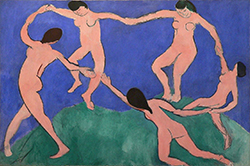 Painting by Henri Matisse: Dance (La Danse). The title refers to either of two related paintings made between 1909 and 1910. The first, preliminary version is Matisse's study for the second version. The composition or arrangement of dancing figures is reminiscent of Blake's watercolour "Oberon, Titania and Puck with fairies dancing" from 1786.
Painting by Henri Matisse: Dance (La Danse). The title refers to either of two related paintings made between 1909 and 1910. The first, preliminary version is Matisse's study for the second version. The composition or arrangement of dancing figures is reminiscent of Blake's watercolour "Oberon, Titania and Puck with fairies dancing" from 1786.
The National Association for the Advancement of Colored People (NAACP) is formed on February 12 in New York City.
Kodak announces a 35 mm "safety" motion picture film on an acetate base as an alternative to the highly flammable nitrate base. The motion picture industry discontinues its use after 1911 due to technical imperfections.
The plastic age begins with the first commercial manufacture of Bakelite.
 William Howard Taft becomes twenty-seventh president of the United States.
William Howard Taft becomes twenty-seventh president of the United States.
Tel Aviv, the first Jewish town in modern Palestine, is founded.
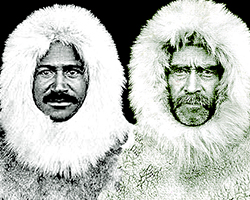 United States explorer Commander Robert E. Peary, accompanied by Matthew Henson, is the first person to reach North Pole.
United States explorer Commander Robert E. Peary, accompanied by Matthew Henson, is the first person to reach North Pole.
 A. E. Garrod publishes Inborn Errors of Metabolism, the earliest discussion of the biochemical genetics of man (or any other species).
A. E. Garrod publishes Inborn Errors of Metabolism, the earliest discussion of the biochemical genetics of man (or any other species).
 George H. Shull advocates the use of self-fertilized lines in production of commercial seed corn. The hybrid corn program that resulted, created an abundance of foodstuffs worth billions of dollars.
George H. Shull advocates the use of self-fertilized lines in production of commercial seed corn. The hybrid corn program that resulted, created an abundance of foodstuffs worth billions of dollars.
H. Nilsson Ehle puts forward the multiple-factor hypothesis to explain the quantitative inheritance of seed-coat color in wheat.
 W. Johannsen's studies of the inheritance of seed size in self-fertilized lines of beans leads him to realize the necessity of distinguishing between the appearance of an organism and its genetic constitution. He invents the terms PHENOTYOPE and GENOTYPE to serve this purpose, and he also coins the word GENE.
W. Johannsen's studies of the inheritance of seed size in self-fertilized lines of beans leads him to realize the necessity of distinguishing between the appearance of an organism and its genetic constitution. He invents the terms PHENOTYOPE and GENOTYPE to serve this purpose, and he also coins the word GENE.
Abbé Breuil depicts a presumed Neanderthal burial at La Ferrassie.
Arthur Smith Woodward lectures the British Association for the Advancement of Science on "excess growth" and tooth loss in dinosaurs, citing these things as evidence of "racial senility" that doomed the dinosaurs to extinction.
Charles Doolittle Walcott starts digging fossils of soft-bodied animals in the Burgess Shale in the Canadian Rockies. He proceeds to publish several papers in which he describes these animals, which lived over 500 million years ago, as primitive ancestors of modern groups.
1909
(no entry for this year)
ESP Quick Facts
ESP Origins
In the early 1990's, Robert Robbins was a faculty member at Johns Hopkins, where he directed the informatics core of GDB — the human gene-mapping database of the international human genome project. To share papers with colleagues around the world, he set up a small paper-sharing section on his personal web page. This small project evolved into The Electronic Scholarly Publishing Project.
ESP Support
In 1995, Robbins became the VP/IT of the Fred Hutchinson Cancer Research Center in Seattle, WA. Soon after arriving in Seattle, Robbins secured funding, through the ELSI component of the US Human Genome Project, to create the original ESP.ORG web site, with the formal goal of providing free, world-wide access to the literature of classical genetics.
ESP Rationale
Although the methods of molecular biology can seem almost magical to the uninitiated, the original techniques of classical genetics are readily appreciated by one and all: cross individuals that differ in some inherited trait, collect all of the progeny, score their attributes, and propose mechanisms to explain the patterns of inheritance observed.
ESP Goal
In reading the early works of classical genetics, one is drawn, almost inexorably, into ever more complex models, until molecular explanations begin to seem both necessary and natural. At that point, the tools for understanding genome research are at hand. Assisting readers reach this point was the original goal of The Electronic Scholarly Publishing Project.
ESP Usage
Usage of the site grew rapidly and has remained high. Faculty began to use the site for their assigned readings. Other on-line publishers, ranging from The New York Times to Nature referenced ESP materials in their own publications. Nobel laureates (e.g., Joshua Lederberg) regularly used the site and even wrote to suggest changes and improvements.
ESP Content
When the site began, no journals were making their early content available in digital format. As a result, ESP was obliged to digitize classic literature before it could be made available. For many important papers — such as Mendel's original paper or the first genetic map — ESP had to produce entirely new typeset versions of the works, if they were to be available in a high-quality format.
ESP Help
Early support from the DOE component of the Human Genome Project was critically important for getting the ESP project on a firm foundation. Since that funding ended (nearly 20 years ago), the project has been operated as a purely volunteer effort. Anyone wishing to assist in these efforts should send an email to Robbins.
ESP Plans
With the development of methods for adding typeset side notes to PDF files, the ESP project now plans to add annotated versions of some classical papers to its holdings. We also plan to add new reference and pedagogical material. We have already started providing regularly updated, comprehensive bibliographies to the ESP.ORG site.
ESP Picks from Around the Web (updated 06 MAR 2017 )
Old Science

Weird Science

Treating Disease with Fecal Transplantation
Fossils of miniature humans (hobbits) discovered in Indonesia

Dinosaur tail, complete with feathers, found preserved in amber.
Astronomy

Mysterious fast radio burst (FRB) detected in the distant universe.